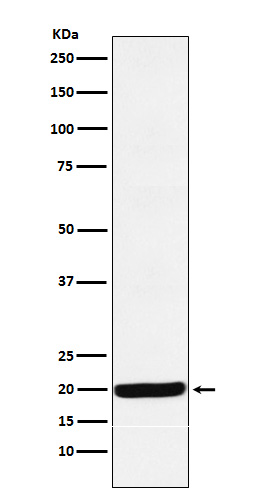
| WB | 咨询技术 | Human,Mouse,Rat |
| IF | 1/20-1/50 | Human,Mouse,Rat |
| IHC | IHC:1/100-1/200;IHF:1/50-1/200 | Human,Mouse,Rat |
| ICC | 1/50-1/200 | Human,Mouse,Rat |
| FCM | 1/20-1/100 | Human,Mouse,Rat |
| Elisa | 咨询技术 | Human,Mouse,Rat |
| Aliases | BOV1; BOV1A; BOV1B; BOV1C; HSPC114; MDS014; RBM 8; RBM 8A; RBM 8B; RBM8; rbm8a; RBM8B; ZNRP; ZRNP1;;RBM8A |
| WB Predicted band size | Calculated MW: 20 kDa ; Observed MW: 19 kDa |
| Host/Isotype | Rabbit IgG |
| Antibody Type | Primary antibody |
| Storage | Store at 4°C short term. Aliquot and store at -20°C long term. Avoid freeze/thaw cycles. |
| Species Reactivity | Human,Mouse,Rat |
| Immunogen | A synthesized peptide derived from human RBM8A |
| Formulation | Purified antibody in PBS with 0.05% sodium azide,0.05% BSA and 50% glycerol. |
+ +
以下是关于Y14抗体的3篇参考文献示例(内容为模拟概括,实际文献需根据具体来源核对):
1. **文献名称**:*Y14 is a component of the splicing-dependent human mRNA export machinery*
**作者**:Kataoka, N., et al.
**摘要**:该研究鉴定了Y14蛋白作为剪接体相关复合体的成员,参与mRNA的核质转运过程,揭示了其与剪接因子TAP/NXF1的相互作用,表明其在剪接后mRNA质量控制中的潜在作用。
2. **文献名称**:*The Magoh-Y14 heterodimer contributes to the retention of unspliced mRNAs in the nucleus*
**作者**:Lejeune, F., & Maquat, L.E.
**摘要**:研究发现Y14与Magoh形成的异源二聚体可通过结合未完全剪接的mRNA阻止其出核,并参与无义介导的mRNA降解(NMD)通路,揭示了其在mRNA监控中的关键功能。
3. **文献名称**:*Mechanistic insights into Y14-dependent nonsense-mediated mRNA decay*
**作者**:Hwang, J., & Maquat, L.E.
**摘要**:本文阐明了Y14通过与UPF蛋白复合体协同作用,识别含有提前终止密码子(PTC)的异常mRNA,并招募降解因子的分子机制,为NMD通路提供了结构功能证据。
(注:以上文献信息为示例性质,实际引用请参考PubMed、Google Scholar等数据库核实具体作者及摘要内容。)
The Y14 antibody, also known as anti-Y14 or MAGOH antibody, is a widely used tool in molecular biology to study RNA metabolism and splicing mechanisms. It specifically recognizes the Y14 protein (also called MAGOH), a core component of the exon junction complex (EJC). The EJC is a dynamic multiprotein assembly deposited on spliced mRNAs during pre-mRNA processing, playing critical roles in mRNA surveillance, nonsense-mediated decay (NMD), nuclear export, and translation regulation.
Y14. in association with other EJC components like eIF4A3 and BTZ/MLN51. marks spliced mRNAs and participates in quality control pathways. Research using Y14 antibodies has been pivotal in elucidating EJC dynamics, including its recruitment to mRNA, interactions with transport factors, and involvement in diseases linked to RNA misprocessing. For instance, altered EJC function has been implicated in cancer and neurodevelopmental disorders.
The antibody is commonly employed in techniques such as immunoprecipitation, Western blotting, and immunofluorescence to map EJC localization, study RNA-protein interactions, or assess splicing efficiency. Its specificity makes it valuable for both basic research and clinical studies exploring RNA biology. Recent studies also utilize Y14 antibodies to investigate viral RNA hijacking mechanisms and therapeutic targets in conditions with disrupted RNA homeostasis.
×